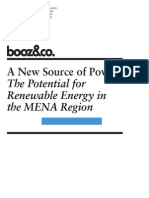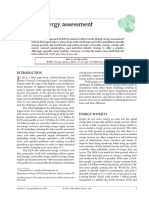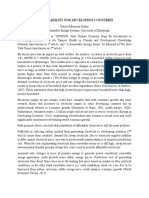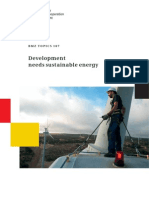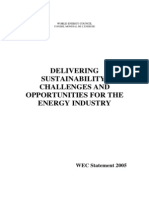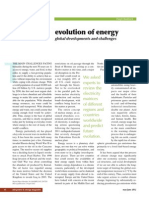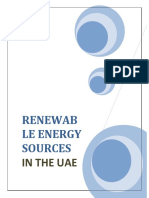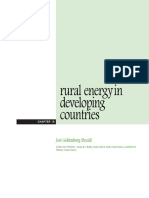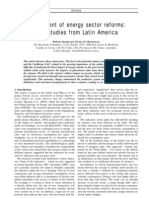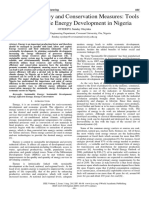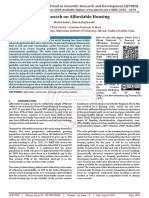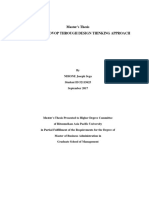Energy Genaration PDF
Energy Genaration PDF
Uploaded by
Mahesh KumarCopyright:
Available Formats
Energy Genaration PDF
Energy Genaration PDF
Uploaded by
Mahesh KumarOriginal Title
Copyright
Available Formats
Share this document
Did you find this document useful?
Is this content inappropriate?
Copyright:
Available Formats
Energy Genaration PDF
Energy Genaration PDF
Uploaded by
Mahesh KumarCopyright:
Available Formats
part IV
where do we go from here?
energy
and economic
CHAPTER 11
prosperity
Dennis Anderson (United Kingdom)
Energy demand in developing countries
ABSTRACT will rise enormously as per capita
incomes and populations grow. By reference to
the situations of people without access to modern
energy forms, the chapter shows why energy
is an economic ‘good’, and thus why energy
supplies will need to be expanded to meet
emerging demands if living standards are to be
improved and developing countries are to
achieve prosperity. Energy demand in industri-
alised countries is also likely to remain
strong, notwithstanding—and to some extent,
because of—continuing gains in the efficiency
with which energy is produced and used. Both
energy resources and financial resources are
amply available to meet market needs.
But will solving the ‘pollution problem’
from energy use prove too costly from an
economic perspective? There is no evidence
that it will, and most assessments point to the
likelihood of an improvement, not a deteriora-
tion, in economic prospects with enlightened
environmental policies. Technologies are now
available for addressing the most serious forms
of local and regional pollution from fossil fuel
use, at costs that are small relative to the costs
of energy supplies. So there is every reason to
be sanguine in this respect. In fact, developing
countries are in a position to address their
local and regional pollution problems at a far
earlier phase of development than were the
industrialised countries before them—within
the first third of this century if they wish.
Furthermore, there are highly promising
options for addressing global warming in the
long term—renewable energy, hydrogen-relat-
ed technologies and fuel cells, for example—
which could be developed through enlightened
research, development, and demonstration
policies.
Much therefore will depend on energy and
environmental policies. In reviewing the
ground rules for such policies, the chapter
shows that the aims of developing countries
for achieving economic prosperity and of
industrialised countries for improving theirs
are fully consistent with those of simultaneously
meeting rising world energy demand and
realising a low-pollution future. ■
394 WORLD ENERGY ASSESSMENT: ENERGY AND THE CHALLENGE OF SUSTAINABILIT Y
Chapter 11: Energy and Economic Prosperity
Modern energy forms are often
espite rising energy taxes, viewed as economic ‘bads’. In fact, this century, much as it did in the
D demand-side interventions, they are an economic good, capable industrialised countries in the last
and supply shortages in many coun- of improving the living century. Large increases in world energy
tries, world consumption of commercial demand thus lie ahead in any scenario of
energy continues to rise. The increase aver- standards of billions economic success. (For further details see
ages 1.5 percent a year, or 150–200 million of people. the scenarios for the growth of populations,
tonnes of oil equivalent energy (6.5–8.5 exajoules) economic output, and energy use in chapter 9.)
a year—an amount equivalent to two-thirds of the annual This chapter provides an economic perspective on
energy consumption in France or the United Kingdom. Developing the questions posed by the prospective increases in consumption:
countries in Asia, Latin America, the Middle East, and Africa account ■ How important is meeting emerging energy demand to the
for most of this growth (table 11.1). In North America, Europe, and achievement of economic prosperity in all regions of the world in
Japan energy markets have matured and aggregate growth is low; in this century? What of the 2 billion people still without access and
the transition economies of the former Soviet Union and Central and the demands of new populations—how are their demands to be met,
Eastern Europe consumption has declined substantially with and what would be the economic and environmental consequences
economic recession and restructuring. of failing to meet them?
The reasons for the rapid growth of consumption in developing ■ What will be the impact on economic growth of meeting the
regions are well known. Income elasticities of demand for energy environmental challenges discussed in chapter 3?
are high, and as per capita incomes grow people want their energy ■ How, and under what conditions, will market liberalisation, the
needs met—just as people in industrialised countries did before changing role of government, and globalisation of the energy
them. Nearly 2 billion people are without access to modern energy industry—all inter-related developments—help to meet the
forms such as electricity and gas, while average consumption levels challenges of achieving energy market growth, extending services
of the 2 billion people who do have access are barely one-fifth of to unserved populations, and solving the environmental problem?
those in the economies of the Organisation for Economic Co- ■ Modern energy forms are often viewed ad economic ‘bads.’ In
operation and Development (OECD). With population growth, fact, they are an economic good, capable of improving the living
perhaps as many as 6 billion more people will require access to standards of billions of people.
modern forms of energy over the next half century. With successful
economic growth—and especially with catch-up in the developing Energy consumption
regions—world economic product is set to rise 10-fold or more and economic well-being
Notwithstanding the historical importance of modern energy forms
in raising economic output, they are often viewed as economic
‘bads’ not ‘goods’—a view that has gathered force in recent years
TABLE 11.1. PRIMARY ENERGY CONSUMPTION
BY REGION, 1987 AND 1997 (EXAJOULES) and is the source of much confusion in energy and environmental
policies. In some countries energy use is under attack not only from
Region 1987 1997 Total Annual percentage environmental groups but also from finance ministries who see high
increase increase
energy taxes as a means of simultaneously raising revenues (which of
United States course they do) and reducing pollution (at most a secondary effect).
and Canada 86 101 15 1.7 In fact, modern energy forms are an economic good, capable of
Europe 74 76 2 0.2 improving the living standards of billions of people, most of all the
billions of people in developing countries who lack access to
Former service or whose consumption levels are far below those of people
Soviet Union 58 38 –20 –4.1
in industrialised countries. It is the pollution arising from energy
South and production and use that is the economic bad, not energy use itself.1
Central America
(including Mexico) 15 20 5 3.4 This distinction, however elementary, is not trivial. Technologies are
available, emerging, or capable of being developed that can solve
Middle East 10 15 5 4.6 the pollution problem at a small fraction of the overall costs of energy
Africa 8 11 3 3.0 supplies. The more policies recognise the distinction, the more likely
will we be able to meet rising world energy demands with greatly
Asia and Pacific 4.8
(including Japan) 64 101 37
reduced pollution. Furthermore, once the benefits of pollution
abatement are taken into account, economic output and well-being
Total 315 362 47 1.5 are likely to be higher not lower.
Note: Converted at the rate of 1 billion tonne of oil equivalent energy = No country has been able to raise per capita incomes from low
43.2 exajoules. Source: BP, 1998. levels without increasing its use of commercial energy. In industrialised
WORLD ENERGY ASSESSMENT: ENERGY AND THE CHALLENGE OF SUSTAINABILIT Y 395
Chapter 11: Energy and Economic Prosperity
unequivocal correlations between the use of energy and power and
TABLE 11.2. PER CAPITA INCOMES AND
CONSUMPTION OF COMMERCIAL ENERGY FOR the quality of life (see figure 1 and table 1 in the overview). A similar
SELECTED DEVELOPING AND INDUSTRIALISED pattern is evident in comparisons of per capita consumption levels
COUNTRIES, MID-1990S
of commercial energy in selected developing countries with those in
Per capita consumption industrialised countries (table 11.2).
Per capita
Country
income, 1995
of commercial energy, These are, of course, simple correlations that leave open the
1994 (gigajoules)a questions of how much energy actually contributes to economic
India 340 10 well-being and how much energy per person is needed to achieve a
satisfactory standard of living. These questions are considered
Ghana 390 4
below, first with reference to people without access to modern
China 620 28 energy supplies in developing countries today and then to people
in industrialised countries before modern energy supplies were
Egypt 790 25
widely available.
Brazil 3,640 30
Korea, Rep. of 9,700
The transition from traditional
125
to modern energy sources
United Kingdom 18,700 158 Alongside the nearly 2 billion people in developing countries who
United States 26,980 327 lack access to electricity and modern fuels2 are some 1.3 billion
people—more than twice the populations of the United States
Germany 27,510 173 and the European Union combined—who were newly served with
a. Converted at the rate of 1 kilogram of oil equivalent = 0.0418 gigajoules. electricity during 1970–95. Large regions of the developing world
Source: World Bank, 1997. are not standing still, and technical progress is making the transition
from traditional to modern fuels possible at a much earlier phase of
countries demand for fossil fuels has expanded more than 50-fold development than was the case for industrialised countries. In the
(in energy units) since 1860. Horsepower per worker in industry United States the transition from 90 percent dependence on wood
and agriculture has grown commensurately and contributed to fuels to virtually none took 70 years (1850–1920), by which time
enormous increases in labour productivity. Cross-sectional data show average per capita income was nearly $5,000 (in 1997 prices).3 In
FIGURE 11.1. USE OF BIOMASS AS A COOKING FUEL RELATIVE TO GNP PER CAPITA IN 80 COUNTRIES
120
y(59=100)
Percentage of biomass in total energy used
100
80
60
40
20
0
1 10 100 1,000 10,000 100,000
GNP per person (1998 US $)
Source: World Bank, 1996.
396 WORLD ENERGY ASSESSMENT: ENERGY AND THE CHALLENGE OF SUSTAINABILIT Y
Chapter 11: Energy and Economic Prosperity
the Republic of Korea the transition was substantially complete industry, and commerce too numerous to list here. Table 11.3 illustrates
by 1980, when average per capita income was about $3,000. For this point with a few comparative statistics for a developing and an
developing countries today the transition to modern fuels tends to industrialised country. Lebergott (1993, p. 112) comments:
be nearly complete when per capita incomes are in the range From 1620 to 1920, the American washing machine was a house-
$1,000-2,000 (World Bank, 1996; figure 11.1). wife. As late as 1920 the family laundry took about seven hours a
Technical progress and lower costs. Why is this transition taking week. The typical housewife washed some 40,000 diapers for her
place at lower incomes? The main reasons are that modern energy four children.4 Lacking running water, she carried 9,000 gallons
forms are more abundant and the costs of energy are much lower [40 tons] of water into the house each year, then boiled most of
than they were when today’s industrialised countries were making it. And she relied on a scrub board, not a washing machine.
the transition. Electricity was not available a century ago, when per The heavy reliance on family labour to provide for the most basic
capita incomes in the now-industrialised countries were five times of energy needs—for cooking food and, in many climates, keeping
those in South Asia and Sub-Saharan Africa today. When electrification the family warm—is an immense opportunity cost to the family.
began, the costs, at $1.7 a kilowatt per hour (in 1997 prices), were When used for pumping, modern energy forms also improve access
20 times today’s costs (World Bank, 1992). Natural gas and liquefied to water. In developing countries today a family of six people consuming
petroleum gas (LPG) were also unavailable. Lebergott (1993, pp. 30 litres of water per person per day (a low level of consumption,
106-107) notes that, notwithstanding the massive increase in energy about one-fifth to one-tenth of that consumed in industrialised
consumption in the United States in the 20th century, as families countries) will fetch and carry by hand around 35 tons of water a
began to heat and later to cool every room in the house, U.S. consumers year from wells and hand-pumps, often over appreciable distances.5
spent no more on heating and cooling their homes in 1990 than Surveys of low income families consistently reveal the economic
they did in 1900: “Despite all the factors driving up expenditures for importance of the saving in family labour made possible by substi-
fuel, …. they actually spent less than 3 percent [of their incomes]— tuting fossil for wood fuels and of the contribution modern energy
compared to 3 percent in 1900. The explanation? Persistent forms may make, among other things, to improving access to water.6
productivity advance by businesses that mined fuel and produced Reductions in pollution and improvements in health. The switch
electricity”. These productivity advances were made possible, in to modern fuels reduces the level of indoor pollution by several
part, by public policies that permitted the energy companies and orders of magnitude, eliminating a major health risk now afflicting
utilities to earn good returns on their investments (this point is billions of people (see chapter 3). A study of air pollution in developing
developed further in the section on liberalisation and globalisation). countries found air pollution levels from biomass combustion at
The importance of per capita income growth. Although modern several multiples of the World Trade Organisation (WHO) peak
energy forms contribute appreciably to economic welfare, they are guidelines: 6 times greater for Zimbabwe, 11 times for China, 5 to
not affordable until incomes rise above a certain threshold (see 34 times for Kenya (daily average), 9 to 38 times for Nepal, 1 to 39
figure 11.1). Technical progress and falling costs are lowering this times for Papua New Guinea, and 16 to 90 times for India (a 15
threshold, but ultimately income growth is what matters. Countries minute peak) (Smith 1988). Fitting stoves with flues lowers pollution
that have been able to raise productivity and incomes on a broad levels to well within WHO guidelines and leads to considerable gains
basis—through good macroeconomic management, trade, and in efficiency as well.
investment in human and physical resources—have been able to
extend service most rapidly.
TABLE 11.3. APPLIANCE USE
IN HOUSEHOLDS WITH ELECTRICITY IN
The benefits of service extension INDONESIA AND THE UNITED STATES, 1987
At the same time, improving access to modern energy forms yields (PERCENTAGE OF HOUSEHOLDS)
appreciable economic and health benefits.
Indonesia
Savings in time and labour in the home. As the World Bank’s Appliance (low-income U.S. households
(1996) report on rural energy and development noted, when wood households)
fuels are scarce, the time people spend collecting fuel is time they
Lighting 100 100
cannot devote to productive activities. Recent surveys in Nepal show
that women spend up to 2.5 hours a day collecting fuel wood and Television 31 100
fodder in areas where wood fuels are scarce. Irons 21 —
The saving in time and labour, however, extends far beyond the
saving arising from the displacement of fuel wood. It includes the Refrigerator 1 100
economic convenience of modern energy forms and the advances Washing machine — 73
they make possible, including hot and running water, washing machines,
refrigeration, food and crop processing, extension of the day through Air conditioning 0 62
electric lighting, and an array and diversity of other uses in homes, — Not available. Source: World Bank, 1996, and Lebergott, 1993.
WORLD ENERGY ASSESSMENT: ENERGY AND THE CHALLENGE OF SUSTAINABILIT Y 397
Chapter 11: Energy and Economic Prosperity
Reductions in environmental damage. The transition to modern
TABLE 11.4. POPULATIONS SIZE
AND ESTIMATED PER CAPITA fuels reduces pressures on forests and land, and thus on watersheds
CONSUMPTION OF COMMERCIAL ENERGY and groundwater resources and even on biodiversity. The dangers
BY COUNTRY GROUP, 1998
of flash flooding are also reduced. By some estimates the consumption
Estimated of wood, crop residues, and animal dung for cooking fuels amounts
Energy form and Population
country group
commercial energy
(millions)
to 1,000 million tons of oil equivalent energy a year, more than three
consumption
times the coal mined in Europe in a single year and twice that mined
Primary energy gigajoules per person in the United States and China in a year (World Bank, 1996). The
• OECD 230 900 same amount of useful heat could be produced with only 100
• Countries of the
former Soviet Union 125 300 million tons of LPG (in oil equivalent units) or 200 million tons
• Developing countries 23 4,800 of kerosene, which is equal to only 3 percent of world oil and
gas consumption.
Peak electricity demand killowatt hours per person
• OECD 1.8 900 Gains in energy efficiency. Thus the transition to modern fuels
• Countries of the can lead to large gains in energy efficiency. LPG and kerosene are
former Soviet Union 0.9 300
• Developing countries 0.2 4,800
just two woodfuel substitutes that result in large efficiency gains. The
use of biogas from agricultural residues leads to similarly large
Note: Consumption estimates are based on statistics for 1992 and OED
projections, assuming a 55 percent load factor for electricity demands.
gains. It is not surprising, therefore, though the point is often over-
Population estimates are based on World Bank projections from 1992. looked, that a rise in commercial energy use among the poorest
Source: OECD, 1995, for consumption; World Bank, 1992, for population. people in the world reduces their energy demand, a pattern that
FIGURE 11.2. RATIO OF ENERGY CONSUMPTION TO GDP
FOR SELECTED COUNTRIES AND REGIONS, 1860–1996, AND PROJECTIONS
45
Projected
40
United Kingdom
Former Soviet Union
30
Energy/GDP ratio
China
20 United States Non-OECD Europe
Germany
World
France
10
India
Latin America
Japan Africa
1860 1870 1880 1890 1900 1910 1920 1930 1940 1950 1960 1970 1980 1990 2000 2010 2020 2030 2040 2050
Note: Energy consumption is measured in megajoules; GDP in 1990 U.S. dollars in purchasing power parity. Pre-1961 GDP calculations are based on
exchange rates. Energy data exclude energy from biomass. Source: IEA, 1997, 1998; CEC 1996; Chandler, and others, 1990; ISI 1999
398 WORLD ENERGY ASSESSMENT: ENERGY AND THE CHALLENGE OF SUSTAINABILIT Y
Chapter 11: Energy and Economic Prosperity
continues until incomes reach quite high levels—in the case of Ambiguities in the evidence
Brazil, for example, to somewhere between 2 and 5 times the minimum and shortcomings in methods
wage (see figure 3 in the overview; chapter 10 provides further data Another perspective on the links between income growth and energy
on the efficiency of the alternative fuels for cooking). consumption is provided by economic estimates of income elasticities
of energy demand. These show a rising trend as per capita income
Energy use forecasts and energy efficiency grows from very low levels and then a declining trend at high
In light of the contribution of modern energy forms to higher income levels (table 11.5). The income effect is weak among the
incomes and greater economic well-being, the expansion of supplies most impoverished people in the world—whose main initial
should be welcomed from both economic and commercial view- demands, as incomes begin to rise, are for meeting such basic
points. Energy markets are potentially very large and are set to grow needs as food, safe water, and improved health services—but
for most of the century. Recall that per capita consumption levels of becomes very strong as incomes rise above a certain threshold.
commercial energy and electricity in developing countries are barely Recall figure 11.1, which shows that once income moves into the
one-tenth of those in OECD countries, while their populations are $1,000–$2,000 range, substitution from biofuels to modern energy
over five times larger (table 11.4). The energy scenarios presented in proceeds as rapidly as income growth permits. The income effect is
chapter 9 point to an increase in the world’s consumption of commer- also strong in the industrialisation phase of development, but it then
cial energy over this century of roughly 2.5 to 5 times today’s levels. begins to decline as markets mature, falling to a low value at high
Forecasts of long-term energy demands vary considerably with income levels, such as those of the OECD economies in the 1970s
assumptions about the growth of per capita incomes and populations.7 and 1980s.
They also vary with assumptions about future gains in energy An intriguing estimation result in table 11.5 is the negative per
efficiency. The assumptions about energy efficiency gains warrant capita income elasticity in the highest income range. Judson,
further discussion because of their impact on assessments of the Schmalensee, and Stoker (1999) caution that this estimate may not
amount of energy required to support economic production and be statistically significant, commenting that it is “more likely to
provide for people’s energy needs. reflect some sort of isolated measurement problem than a real eco-
It has been widely observed that the energy intensity of an economy nomic phenomenon. We are on balance fairly confident that beyond
(the ratio of energy consumption to GDP) rises during the early and per capita incomes of $1,500 or so (in 1985 dollars), there is a
middle phases of economic development, when the industrialisation tendency of the economy-wide income elasticity of demand for
and ‘motorisation’ of economies are strong, and then peaks and energy to fall with per-capita income, but the evidence for a negative
declines as the less energy-intensive service sector begins to occupy income elasticity at high income levels is, in this sample, less
a larger share of economic activity (figure 11.2).8 The later a country
than compelling”.
industrialises, the lower its peak energy intensity because of intervening
Yet engineering studies also point to the possibility of a decline
improvements in the efficiency of energy conversion processes—
in energy demand per capita at high income levels even as per
especially for electricity generation—and energy use. This pattern
capita incomes increase. As energy markets become satiated at
has held for more than a century, as a comparison of the experiences
high income levels, long-term improvements in the efficiency of
of the United Kingdom, Germany, the United States, France, and Japan
energy use may more than offset any further increases in demand
shows (see figure 11.2). Developing regions are exhibiting the same
pattern. (Exceptions are economies in transition, which have
experienced abnormally high energy intensities historically, but which
TABLE 11.5. VARIATION IN PER CAPITA
are now expected to decline with new investment and gains in energy INCOME ELASTICITIES OF DEMAND
efficiency.) A number of engineering and economic studies have FOR COMMERCIAL ENERGY WITH
shown that the possibilities for further gains in energy efficiency are PER CAPITA INCOMES
far from exhausted, such that we can expect a continual lowering of Income (1985 U.S. dollars Income
the peak intensity as more countries become developed.9 in purchasing power parity) elasticity
Such improvements in energy efficiency mean that developing
≤ 823 0.219
countries are likely to need less energy to produce a unit of GNP and
to meet consumer needs per unit of income than was the case for 823-1430 1.098
the industrialised countries. How much less is controversial, 1,430-2,545 1.400
because of ambiguities in the evidence and oversimplifications in
both the engineering and economic models of energy consumption. 2,545-4,249 0.784
However, no empirically based study has shown that developing 4,249-8,759 0.394
countries can achieve prosperity without very large increases in
demand for energy, even with strong assumptions about improvements ≥ 8,759 –0.312
in energy efficiency. Source: Judson, Schmalensee, and Stoker, 1999.
WORLD ENERGY ASSESSMENT: ENERGY AND THE CHALLENGE OF SUSTAINABILIT Y 399
Chapter 11: Energy and Economic Prosperity
Per capita consumption levels of
arising from income growth.10 The commercial energy and electricity economic benefit of energy efficien-
effects are complex, and it is not in developing countries are cy: it makes energy more affordable
surprising that the study by Judson, barely one-tenth of those and accessible to consumers, which is
Schmalenensee, and Stoker (1999) is especially important today for develop-
inconclusive. Economic models have so in OECD countries. ing countries.12
far not been able to capture the effects in a Consider the following examples. The effi-
satisfactory way. ciency of motive power rose from less than 1 per-
There are five effects on energy demand that need to be cent for the early steam engines of Newcomen and Smeaton
considered: income, price, population, energy efficiency as a means in the 18th century and 5 percent with the invention of the stream
of reducing energy demand for a particular purpose, and energy condenser by Watt later in the century to 20 percent for gasoline and
efficiency as a means of reducing the price of energy and thereby diesel engines and 40 percent for electric motors today (after allow-
raising energy demand (sometimes called the rebound effect). ing for losses in electric power stations). This was a 40-fold
These effects can be summed up in the simplified model of energy increase over two centuries. It is conceivable that without such effi-
demand growth: ciency improvements the industrial revolution—and the unprecedented
e = γ.g - β.p{x} – x + n increase it brought about in per capita incomes in the industrial
where e is growth of per capita energy demand; g is growth of per economies in the past two centuries—might not have taken place.
capita income; p is growth of prices; n is population growth; x is Or consider lighting. The efficiency in lumens per watt rose 20-fold
the growth of what is sometimes called the autonomous energy following the displacement of kerosene by electric incandescent
efficiency index; γ is the income elasticity of demand for energy; and lamps and then another 5-fold with the invention of fluorescent
β is the numerical value of the price elasticity. The notation p{x} lamps in the 1930s. These improvements help explain the massive
summarises the fifth effect, of price as a function of—and generally growth in commercial lighting over the past half century. Another
declining with—energy efficiency. socially important example, mentioned earlier, is the contribution of
Most energy demand studies using econometric techniques have modern fuels to the efficiency of cooking and heating devices in the
not attempted to estimate x, the rate of improvement in the homes. These were a primary cause of the movement away from
autonomous energy efficiency index. The review by Grubb and traditional fuels and of improvements in the economic well-being of
others (1993, p.453) sums up the uncertainties. First they note the billions of people.
wide range—from less than 0.5 percent to more than 1.5 percent a To take a final example, the conversion efficiency of power
year—in x. They then add: stations fired by fossil fuels rose from around 3 percent at the
We cannot suggest a definite value for this parameter, but it is beginning of the 20th century to more than 50 percent for
important to understand it. The parameter has been badly combined-cycle gas-fired power stations today (Anderson, 1993).
misnamed: it is a measure of all non-price-induced changes in This improvement has contributed to a 20-fold drop in the costs of
gross energy-intensity—which may be neither autonomous nor electricity since 1900, stimulated industrial expansion, and brought
concern energy efficiency alone. It is not simply a measure of the benefits of electricity consumption to more than 3 billion
technical progress, for it conflates at least three different factors. people in the world today. Numerous other examples could be cited,
One indeed is technical developments…. another is structural from commercial heating (insulation, heat pumps, double glazing,
change, i.e., shifts in the mix of economic activities…. The third energy management systems, combined heat and power) and air
is policy-driven uptake of more efficient technologies.… conditioning to refrigeration and industrial processes.
[Emphasis in original.] In sum, the main benefits of improvements in energy efficiency
Compounded over a century, the 1 percentage point difference in are that they make modern energy services more affordable and
estimates of the autonomous energy efficiency index results in a 2.7- accessible by reducing the energy required for any particular purpose
fold difference in energy demand projections and helps to explain and thereby reducing costs. It is only in the high-income economies
the large differences in the scenarios of energy demand developed that there is some suggestion that per capita energy use might
in chapter 9. eventually decline as incomes grow and energy needs become satiated.
In developing countries, however, demand is set to grow substantially,
Energy efficiency as even allowing for—and to some extent because of—improvements
a beneficial stimulus to energy use in energy efficiency, in any scenario of economic success.13
Environmental studies frequently argue for improvements in energy
efficiency as a means of reducing environmental damage. There are, Reconciling increased
however, two dangers in placing too much reliance on this argument. energy consumption and
One is that improving energy efficiency, by lowering costs and environmental protection
prices, may also increase demand (the rebound effect noted Two important issues that arise in any discussion about meeting
above).11 The second is that the argument neglects an important growing energy demand are: What will be the environmental impact,
400 WORLD ENERGY ASSESSMENT: ENERGY AND THE CHALLENGE OF SUSTAINABILIT Y
Chapter 11: Energy and Economic Prosperity
and can the impact be ameliorated at an affordable cost for developing across sources and locations and are much higher for small
countries? To answer these questions we need to distinguish between (low-stack) sources because of the dispersion pattern.
local and regional pollution on the one hand and global pollution ■ For some fuel uses the marginal damage costs are as high as
from greenhouse gases on the other. For local and regional pollution producer and retail prices—or even higher.
the technologies are well developed, based on 40 years of operational ■ Diesel-powered vehicles and small stoves or boilers burning
experience in industrialised countries. For global warming the coal, wood, or oil impose the highest social costs per ton of fuel.
required technologies, while promising, are at a much earlier phase ■ Sulphur deposition levels are already at 5–10 grams per square
of development and use and raise different issues for policy. meter per year in the industrial areas of Indonesia, Malaysia, the
Philippines, and Thailand, and at more than 18 grams in China.
Reducing local and regional pollution By comparison, deposition levels in the most heavily polluted
Studies have estimated high social costs of pollution from energy parts of the industrialised world—the black triangle of Central
production and use in developing countries (Lvovsky and Hughes, and Eastern Europe—are about 15 grams.
1999; Lovei, 1995; Downing, Ramankutty, and Shah, 1997). The ■ Local health effects dominate the damage costs. Lead blood
costs of pollution in cities are especially high: levels during the early 1990s were 25 micrograms per decilitre
■ Marginal damage costs per ton of local pollutants vary greatly in Mexico City and Budapest, 30 in Cairo, and 40 in Bangkok,
TABLE 11.6. RELATIVE POLLUTION INTENSITIES AND COSTS OF SELECTED LOW-POLLUTING TECHNOLOGIES
FOR ENERGY PRODUCTION AND USE (INDEX = 100 FOR ALL HIGH-POLLUTING TECHNOLOGIES)
Costs as share
Low-polluting
Source and pollutant of supply or user Nature of low-polluting alternatives
technology costs (percent)a
Electricity generation (coal) Natural gas; electrostatic precipitators,
Particulate matter <0.1b <0–≈2b bag-house filters, flue gas desuphurization,
Sulphur dioxide 0–0.5 5 integrated coal gasification combined-
Nitrogen oxides 5–10 5 cycle technologies, and fluidised bed
combustion (for coal); low nitrogen oxides
combustion and catalytic methods.
Motor vehicles Unleaded/reformulated fuels; catalytic
Gasoline engines converters.Improved fuel injection, engine
Lead 0 design, maintenance. and ‘proper’ fuel
Carbon monoxide 5 ≈4–5 share use; catalytic converters.
Nitrogen oxides 20 of lifetime cost of
Volatile organic compounds 5 vehicle fuel and
Diesel engines equipment costs,
Particulate matter ≈10–20 for gasoline and
Nitrogen oxides ≈40 diesel engines
Traditional household fuels (wood and dung) Gas, kerosene.
in low income countries
Smoke (particulate matter,
carbon monoxide, and sulphur) <0.01 <0d
Carbon dioxide emissions from Advanced solar energy, wind, and other
combustion of fossil fuels renewable energy technologies for power
Electricity (developing countries) 0 generation; biomass for liquid fuels and
Electricity (developed countries) 0 ≈0–≈20e power generation; hydrogen from renewable
Liquid fuel substitutes 0 ≈30–50 energy sources and fuel cells for power
generation and vehicles.
Note: Except for carbon dioxide all the estimates are based on technologies and practices commonly in use.
a. Net private marginal costs are used because some technologies and fuels have benefits that go beyond their environmental benefits—use of gas as a
domestic and industrial fuel is an example. Such investments are routinely justified in terms of their economic convenience or productivity relative to the
alternatives, without reference to their environmental benefits, however important. b. Negative costs arise if gas is available for power generation as a
substitute for coal. c. High emissions (especially of particulate matter) in developing countries stem very much from ageing vehicles, poor maintenance,
and improper use of fuels (for example, kerosene instead of diesel). d. In urban areas and where traditional fuels are scarce, modern fuels are generally
cheaper to use once the costs of household labour are taken into account, in part because of their higher energy efficiency (see chapter 10) and their
convenience and savings in time (see discussion in text). e. Estimates are much lower for developing countries than for the northern industrialised countries
because solar insolation is two to three times greater in developing regions and its seasonal fluctuation is one-third less. Estimates are of long-term costs.
Source: ADB, 1991, and Charpentier and Tavoulareas, 1995 for electricity; Faiz, Weaver, and Walsh, 1996, for motor vehicles; Smith, 1993, for traditional fuels.
Anderson and Chua, 1999, review the engineering economic literature, and Kiely, 1997, provides an introductory text on technologies; both have ample bibliographies.
WORLD ENERGY ASSESSMENT: ENERGY AND THE CHALLENGE OF SUSTAINABILIT Y 401
Chapter 11: Energy and Economic Prosperity
FIGURE 11.3. TRENDS IN SULPHUR DIOXIDE EMISSIONS, SELECTED COUNTRIES, 1980–96
120
Czech Republic
100
United States
United Kingdom
80
60 Finland
Hungary
40
Western Germany
20
0
1980 1981 1982 1983 1984 1985 1986 1987 1988 1989 1990 1991 1992 1993 1994 1995 1996
Source: Data from OECD, 1997; U.S. EPA, 1997; and U.K. Department of Environment, Transport, and the Regions National Air Quality Archive (http://www.aeat.couk/netcen/airqual/).
well above the 2 micrograms per decilitre in the United States The costs of controlling local and regional pollution are small
(reflecting an eightfold decline over the preceding 15 years). relative to the total costs of energy supply or use. If coal is used as
There are several options for substantially reducing local and the principal fuel in electricity generation, the costs of pollution
regional pollution loads over the long term. This is evident both abatement range from 2 percent of supply costs for particulate matter
from the experience of industrialised countries (table 11.6) and (the most environmentally damaging of pollutants) to 5–10 percent
from comparisons of pollution loads in industrialised and developing for acid deposition. If gas is used as the principal fuel, the costs of
countries (figure 11.3). Given the time required to incorporate low- pollution abatement are negative once allowance is made for the
polluting options in new investments and to replace the old capital higher thermal efficiencies and lower capital costs of the power
stock, however, pollution is likely to rise before it falls. But the experiences plant. For motor vehicle emissions the absolute cost of abatement,
of industrialised countries also shows that there is little doubt that including the cost of catalytic converters, is estimated at less than
major reductions of local and regional pollution from energy use $0.04–0.15 per gallon of fuel consumed. Similarly, supplying modern
could be achieved in the long term with supportive policies. fuels to households in place of traditional fuels significantly reduces
Low-polluting technologies, in wide use in industrialised countries, both indoor and local pollution (see chapter 3) and, except in remote
have led to appreciable reductions in smog, acid deposition, and emissions communities, the costs of energy supplies as well.
of lead, particulate matter, and volatile organic compounds; and Simulations of the effects of introducing abatement policies for
although energy consumption per capita is an order of magnitude reducing acid deposition in Asia illustrate the potential of innovation
higher than in developing countries, local and regional pollution is for enabling developing countries to address environmental problems
an order of magnitude or more lower or (in the case of acid deposition) at an earlier phase of their development than did industrialised
headed in that direction. (See chapter 3 for a full discussion of pol- countries (Anderson and Cavendish, 1999; figure 11.4). Studies that
lution loads in the industrialised and developing countries.) assume that environmental problems will not be addressed until the
402 WORLD ENERGY ASSESSMENT: ENERGY AND THE CHALLENGE OF SUSTAINABILIT Y
Chapter 11: Energy and Economic Prosperity
For some fuel uses
per capita incomes of the main the marginal damage costs pollution control — the central
emitters in the region (China and are as high as producer goal of internalising externalities in
India) approach those of industrialised and retail prices—or market prices. Simulation studies
countries when they began to address consistently show that the extra invest-
acid deposition in the 1970s (about even higher. ments would not only become self-financ-
$10,00014) put that date at half a century from ing, but would over time be offset by efficiency
now for China and nearly a century from now for gains in the industry as a result of new thermal efficien-
India, even under optimistic growth rate assumptions. When cies in power plants, improvements in plant availabilities,
the simulations are run under the assumption that countries in reductions in distribution losses, and gains in managerial efficiency
Asia take advantage of new methods of sulphur dioxide abatement from liberalisation and improved forms of regulation (Cavendish
that have emerged in recent years, including coal desulphurization and Anderson, 1994; World Bank, 1992). Thus while subsidies should
and the use of gas for power generation (now a rapidly growing not be necessary to finance investments in reducing local or regional
possibility in East Asia), the results clearly show the opportunity for pollution, environmental regulation and taxation would be.
solving the problem much earlier with greatly reduced pollution In addition, experience in industrialised countries has shown
loads. Downing, Ramankutty, and Shah (1997), in a study of acid that there are good economic returns to such investments through
deposition in Asia, come to similar conclusions; so do the scenarios improvements in people’s health and reduced damage to natural
in chapter 9. resources (chapter 3). In a review of U.S. experience, Davies and
The relatively low costs of pollution control suggest that the Mazurek (1998, p. 148) conclude that:
required financing can be generated through policies that allow The macroeconomic effects of pollution control and regulation
prices to reflect the marginal costs of supply, including the costs of are generally modest. Regulation has had some adverse effects
FIGURE 11.4. SIMULATED EFFECTS ON SULPHUR DIOXIDE EMISSIONS
IN ASIA OF EARLY AND LATE ENVIRONMENTAL POLICIES
7 100
Real GDP per capita (thousands of 1985 U.S. dollars)a
Environmental Kuznets curve
6
Delayed policy
Emissions per capita (Index: year 0 = 1)
Per capita income
5
10
Early policy
0 1
0 10 20 30 40 50 60 70 80
Time (years)
a. Adjusted for real comparative purchasing power using Penn World Table, mark 4 (Summers and Heston, 1991).
Source: Anderson and Cavendish, 1999; Selden and Song, 1994, for the environmental Kuznets curve.
WORLD ENERGY ASSESSMENT: ENERGY AND THE CHALLENGE OF SUSTAINABILIT Y 403
Chapter 11: Energy and Economic Prosperity
on GDP growth, but most economists think that the effect is some resistance to the notion that developing countries should
has been relatively small, and the negative effect fails to take not use fossil fuels to further economic development, as the indus-
into account most of the benefits of regulation…. When looked trialised countries did in the 19th and 20th centuries.
at as a whole, U.S. environmental progress has made economic Yet developing countries may stand to benefit unexpectedly over
sense. It can be shown that benefits exceed costs in a great the long term from international policies on climate change, particularly
number of cases. from the use of the renewable energy technologies now emerging
In developing countries the net effects on growth should be even from the energy research, development, and demonstration (RD&D)
greater, since their environmental priorities in the energy sector programmes of the industrial countries. In fact, some countries,
include the elimination of smoke, emissions of particulate matter, such as Brazil, China, and India, have themselves begun to put resources
lead in fuels, and the indoor air pollution and damage to soils and into the development of renewable energy. The development and use
forests arising from the use of traditional fuels. Thus there is no rea- of renewable energy have also become a focal point of the Global
son from an economic perspective why developing countries cannot Environment Facility, the financing arm of the United Nations
adopt ambitious policies for reducing local and regional pollution Framework Conventions on Climate Change and Biodiversity. What
from energy production and use. The technologies and practices makes the technologies promising is the abundance of renewable
are now available that should, if the ‘right’ policies are put in place, energy resources and the falling costs being brought about by technical
enable developing countries to reduce such sources of environmental progress. (For more detailed information about renewable potentials
damage at a much earlier phase of development than was the case and technologies, see chapters 5 and 7.)
for industrialised countries. Abundant renewable energy resources. The Earth receives a
yearly energy input from the sun equal to more than 10,000 times
Mitigating global warming the world’s consumption of commercial energy. Solar insolation
The other energy-related environmental concern is global warming. varies from 2,000 kilowatt hours per square metre to more than
For understandable reasons developing countries have been reluctant 2,500 a year over vast areas of developing countries, from
to commit themselves to emission reduction targets for greenhouse 800 to 1,700 in Europe, and from 1100 to over 2,500 in the
gasses. The costs of mitigation are thought to be too high, and there United States. Photovoltaic systems and solar-thermal power stations
TABLE 11.7. USE AND COMPARABLE COST OF SELECTED RENEWABLE ENERGY TECHNOLOGIES, 1998
Average cost (U.S. cents
Technology per kilowatt hour unless Comments
otherwise indicated)
Wind (electric power) 5–13 Costs declined fivefold from 1985 to 1995.
Biomass
Electric power 5–15 Steam cycle of 25 megawatts Brazil data. Declined by factor
Ethanol $2–3/gallon ($15–25 gigajoule) of three since 1980s.
Photovoltaic systems Based on costs of $5–10/peak watt. Costs have declined
Insolation, 2500 kilowatt hours/square metre 20–40 50-fold since 1975, 5-fold since 1980, 2-fold since 1990.
Insolation, 1500 kilowatt hours/square metre 35–70 Medium- and long-term storage a major issue. With battery
Insolation, 1000 kilowatt hours/square metre 50–100 storage, cost of $8–40/ peak watt in off-grid, stand-alone
applications are commonly reported; see chapter 7.
Thermal solar (electric power) 10–18 Parabolic troughs. Latest vintages, around 1990, in high
insolation areas only.)
Geothermal 3–10 Costs vary greatly with location.
Gas-fired, combined-cycle power plant 3–5 Higher figure is for liquefied natural gas.
Grid supplies
Off-peak 2–3 Depends on spikiness of peak
Peak 15–25
Average, urban areas 8–10
Average, rural areas 15 to >70 Rural areas in developing countries
Note: All figures are rounded. Estimates are adjusted to 10 percent discount rates.
Source: Based on the author’s interpretations of the following reviews, of more than 500 papers and studies: Mock, Tester, and Wright, 1997, on geothermal;
Larson, 1993, on biomass; Ahmed, 1994, on solar and biomass; Gregory, 1998, on several technologies, including fossil fuels; World Bank, 1996,
on renewable energy and grid supplies in rural areas; and chapter 7 of this report. Refer to those sources for details and qualifications.
404 WORLD ENERGY ASSESSMENT: ENERGY AND THE CHALLENGE OF SUSTAINABILIT Y
Chapter 11: Energy and Economic Prosperity
Developing countries
are capable of converting 10–15 may enjoy a five-to-one International Energy Agency have
percent—15–30 percent with further cost advantage in such policies in one form or anoth-
development—of the incident solar using direct solar er, aimed at developing new alterna-
energy into electricity. tives to fossil fuels. International eco-
In theory, all of the world’s primary energy technologies. nomic co-operation to foster trade, invest-
requirements of 8 gigatons of oil equivalent a ment, and the diffusion of know-how in these
year could be met on an area of land equal to about technologies has also begun to emerge, albeit on a
0.25 percent of the land now under crops and permanent small scale considering the task in hand (see section on lib-
pasture.15 There is thus no significant land constraint on the use eralisation and globalisation).
of solar energy. The main issue is cost. Other renewable energy The principal example of international co-operation is the Global
technologies, such as biomass and wind power for electricity Environment Facility. The marketable permit systems and other flex-
generation, have greater land intensities than solar energy; they have ibility mechanisms of the Joint Implementation and Clean
already attracted significant investment.16 Development Mechanism, if implemented, will be important exten-
Encouraging technical progress and falling costs. The relative sions of these initiatives. But while public support for commerciali-
costs of fossil fuels and renewable energy can be assessed only within sation and international co-operation has been growing, energy
broad limits, even assuming reasonable stability of fossil fuel prices RD&D programmes in OECD countries have declined precipitously
(table 11.7). The estimates shown indicate why niche markets have in the past 20 years. Many question whether they have declined too
emerged for renewable energy in favourable locations: geothermal, far, considering the severity of environmental problems and the
wind, biomass for power generation; solar thermal in areas of high competition from fossil fuels (see box 11.1 for a discussion of ener-
insolation; and photovoltaic systems for off-grid markets and for gy research and development).
distributed generation when there is a good co-incidence of solar Cost uncertainties and scenarios of carbon emissions. Notwithstanding
peak and demand peak. Renewable energy installations (excluding the promise of renewable energy, the uncertainties remain appreciable.
hydropower) generate about 30,000 megawatts world-wide. While The future use of renewable energy will depend on its costs relative
small relative to the world’s generating capacity (more than 3 million to the costs of fossil fuels and on taxes and regulation of carbon
megawatts), this experience has provided good information on the emissions. Minor changes in assumptions about the effects of innovation
costs and reliability of renewable energy technologies. on costs, when extrapolated over long periods, lead to large differences
Two factors, often neglected, are also important to cost calculations. in estimates of the energy supply mix, as do differences in assump-
One is the comparative advantage developing countries may have in tions about climate change policies.
using renewable energy. Solar insolation, for example, is two to It is possible (and many people hold this view) that renewable
three times greater than in the northern regions of industrialised energy will remain confined to niche markets in the absence of
countries, and seasonal swings are much lower. For this reason climate change policies. It is also possible (and many others hold
developing countries may enjoy a five-to-one cost advantage in using this view) that with further innovations and scale economies in
direct solar technologies. The second factor concerns differences manufacturing and marketing, renewable energy will eventually
between average and marginal costs. In off-peak times the marginal meet a substantial share of the world’s energy needs.
cost of grid supplies may be one-quarter to one-third the average Uncertainties about the costs of non–fossil fuel technologies and
cost, while in peak times marginal costs can be as much as two to different assumptions about climate change policies are the main
five times higher than average costs—or even more. This differential reasons why scenarios of carbon emissions differ so greatly.
has been obscured in many countries by the common practice of Industry scenarios (for example, Kassler’s 1994 report for the Royal
average cost pricing and, too often, by subsidies. But when there is Dutch Shell group of companies) and the recent lower emission
a good co-incidence between solar peaks and demand peaks, there scenarios of the International Panel on Climate Change (Nakićenović,
is an economic case for using photovoltaic systems for distributed Victor, and Morita, 1998) show carbon emissions rising from
generation. Better efficiency in the level and structure of prices will 6 gigatons of carbon a year today to a peak of 10 gigatons by the
also be needed to provide proper incentives for solving the problem middle of the century and then declining to low levels by the end of
of intermittence in renewable energy supplies. Differential pricing, the century. These scenarios also allow for the emergence of other
with high peak and low off-peak rates, provides the ideal incentive. non–fossil fuel technologies and for technological surprise.
Such pricing structures have already emerged at the bulk supply These results can be reproduced using elementary simulation
level in some countries with liberalised electricity markets (the models. The results of one such simulation for a developing country
United Kingdom is a prominent example). are shown in figure 11.5. They contrast the emissions associated
Energy research, development, and demonstration. But we need with the country’s early introduction of climate change policies with
to go beyond the (undoubtedly important) principle of ‘getting those that would arise if the country were to wait until its per capita
prices right’ for commercial investment and to revisit the case for income began to approach that of industrialised countries today, a
technology development policies. Most member countries of the projected delay of roughly half a century. Note the long lags before
WORLD ENERGY ASSESSMENT: ENERGY AND THE CHALLENGE OF SUSTAINABILIT Y 405
Chapter 11: Energy and Economic Prosperity
the full effects of the policies are felt, a (further) delay that arises a technological and an economic surprise arising, so that alternatives
from the scale of the problem of replacing fossil fuels in the energy might become less expensive than fossil fuels for a large number of
supply mix and the longevity of investments in energy supplies from applications. This outcome is consistent with the findings of the
fossil fuels. industry scenarios (Kassler, 1994). We cannot say with certainty that
There is a wide range in costs for the early policy scenario. such a favourable outcome will materialise, and it may well be that
Significant investment would be required in the early decades, as is a transition to renewable energy will eventually require a permanent
clear from the data in table 11.7 and from the report of the President’s and significant tax or regulation on the use of fossil fuels. But
Committee of Advisers on Science and Technology noted in box reflecting on the technological developments and reductions in the
11.1. However, the costs in the long term may well prove to be small costs of energy over the past century, who could say with confidence
or negative. When the full probability distributions for the parameters that the scope for innovation in alternatives to fossil fuels is exhausted
representing the effects of technical progress on costs are included or that addressing climate change is unlikely to yield a technological
in the analysis, it can be shown that there is a significant chance of or an economic surprise?
BOX 11.1. HAS PUBLIC SUPPORT FOR ENERGY RESEARCH AND DEVELOPMENT DECLINED TOO FAR?
Public support for energy research, initiatives that avoid the problems encountered incentives for RD&D? The costs of the
development, and demonstration (RD&D) previously under state-directed programmes. non-fossil components of energy RD&D
programmes in OECD countries has declined The main issue is whether the incentives programmes are about $2.3 per ton of carbon
considerably since 1985: by 80 percent in provided today are sufficient in light of the emitted in IEA countries including nuclear
Germany, 75 percent in Italy, 50 percent in emerging environmental problems and the power and less than $1 per ton excluding
Canada, and 10 percent in Japan (where, as continuing competition from fossil fuels. nuclear power. Economic estimates of the
in France, nuclear power occupies the bulk The U.S. President's Committee of Advisers carbon taxes required to address the climate
of the budget) and the United States (IEA on Science and Technology (1999, p. ES-5) change problem are much larger, at five to
1997a). Recent public energy RD&D concluded that they are not. “[U.S. federal several hundred dollars per ton.1 When
expenditures in International Energy Agency RD&D programmes] are not commensurate in uncertainties are large, as they are in the case
(IEA) countries are about $8.5 billion a year. scope and scale with the energy challenges of developing technological alternatives in
About 55 percent of spending goes for and opportunities the twenty-first century will response to a highly uncertain problem such
nuclear power and 40 percent for renewable present….especially…in relation to the challenge as global warming, it is a good policy, well
energy and conservation. of responding prudently and cost-effectively supported by the principles of economic
In most countries the cuts were made to the risk of global climatic change from analysis, to invest in options that reduce
across the board and equally applied. society’s greenhouse gas emissions”. Yet on a uncertainties and costs.
The cuts were motivated in part by market per capita basis U.S. RD&D programmes on
liberalisation, whose aim was to shift the 1. “The World Bank Global Carbon Initiative”, attachments
non-fossil and non-nuclear technologies are to a published speech by James D. Wolfensohn to the UN
onus for innovation to the private sector, and among the largest in the OECD (see figure). General Assembly, June 25, (available from the World Bank
in part by competing demands on public What are the alternatives to providing Global Environment, Washington D.C.).
revenues for social sector programmes.
The decline in public support for RD&D also
reflects discouragement with state-selected Public expenditure per capita on energy RD&D
programmes supported by direct state
expenditures in the period from around 35
1950 to 1990.
Following a major re-assessment of ■■ Fossil and nuclear
the approach over the past 15 years, public 30
■■ Non-fossil and non-nuclear
policies in several OECD economies are now
U.S. dollars per capita
moving towards a complex mix of incentives 25
based on:
• Regulatory requirements for private 20
industry to develop technologies with
low carbon emissions.
• Technology-neutral tax incentives for the 15
development of low carbon technologies.
• Marketable permit and related systems, 10
such as the proposed programmes of
Joint Implementation and the Clean 5
Development Mechanism.
• Special financing facilities such as the
Global Environment Facility that blend 0
Japan Norway France Canada Sweden Italy Germany United
their own concessionary or grant finance Kingdom
Switzerland Netherlands United Denmark Belgium Austria Spain
with the hard finance of the multilateral States
development banks and industry to
achieve a softer financial blend for Note: This figure understates the actual level of public RD&D in energy related matters since
innovative environmental projects. RD&D in some sectors—in transport and building sectors in particular—also has a large bearing
These are all clearly more market-oriented on the development of energy-efficient technologies and practices. Source: IEA 1997a.
406 WORLD ENERGY ASSESSMENT: ENERGY AND THE CHALLENGE OF SUSTAINABILIT Y
Chapter 11: Energy and Economic Prosperity
FIGURE 11.5. SIMULATED EFFECTS OF ENVIRONMENTAL POLICY ON
CARBON DIOXIDE EMISSIONS FOR A DEVELOPING COUNTRY
7 100
Half-century delay in policy introduction
Real GDP per capita (thousands of 1985 U.S. dollars
Index of emissions per capita (Index: year 0 = 1)
in purchasing power parity prices)
Per capita income
5
10
Early policy introduction
0 1
0 10 20 30 40 50 60 70 80 90 100
Time (years)
Note: Initial GDP per capita is $1,500 and growth is 3 percent a year. The early fluctuations in emissions in the ‘early policy’ case arise from the initial
price effects on demand. Source: Special run by the author using the model described in Anderson and Cavendish, 1999.
Competition from fossil fuels and lessons from the history of discoveries, but also by technological progress in exploration and
nuclear power. In addition to the above-mentioned uncertainties, production and throughout the downstream industries. In addition,
competition from fossil fuels continues to increase. Estimates of fossil continued technological progress in the electricity industry reduced
fuel reserves are far greater today than they were 40 years ago, when both the capital and the fuel costs of generation from fossil fuels. In
nuclear power programmes were being initiated. Estimates for the the 1950s the thermal efficiencies of new fossil fuel–fired stations
1955 UN Atoms for Peace Conference put proven reserves at 480 were 30–35 percent; today they are around 45 percent for new
gigatons of oil equivalent and ultimately recoverable reserves at coal-fired plant and 55 percent for gas-fired plant.
2,300 (United Nations, 1955)—respectively one-quarter and one- Technological progress and discoveries of reserves thus reduced
twelfth of current estimates. With the convenience of hindsight, we the costs of power generation from fossil fuels relative to nuclear
now know that the underlying premise of the nuclear power power. The history of oil and gas is replete with predictions of
programmes that were being advocated at the time—that fossil fuels rapidly depleting reserves and rising prices.18 In addition, there are
would be severely depleted by the first half of the 21st century—was promising options for hydrogen production from natural gas and
wrong, as were two other assumptions: that growing pressures on for coal bed methane in which carbon dioxide is re-injected in coal
reserves would increase the costs of fossil fuels, while technical beds for enhanced methane recovery (on a closed, non-net-carbon-
progress would lower those of nuclear power. emitting cycle), used for enhanced oil recovery, or sequestered
In fact, the opposite happened. Except during the oil price deep in saline aquifers (see chapter 8). In sum, non–fossil fuel
shocks of the 1970s, real oil prices have consistently been in the technologies, including the emerging renewable energy technologies,
$10-20 per barrel range (in 1995 dollars) for 120 years, despite will continue to face intense competition from fossil fuels for many
huge increases in demand. The prices of coal and natural gas (per years ahead.
unit of energy) have generally been even lower than those of oil (BP Nevertheless, from an economic perspective the evidence allows
1996).17 Low costs were made possible not only by continued for an optimistic conclusion: technologies are emerging that should
WORLD ENERGY ASSESSMENT: ENERGY AND THE CHALLENGE OF SUSTAINABILIT Y 407
Chapter 11: Energy and Economic Prosperity
the century.19 Even at the higher end these estimates would amount
BOX 11.2 HOW MARKET LIBERALISATION AND
EDUCATION POLICIES INTERACT TO AFFECT to less than two year’s growth of world product over a 50 year
GROWTH AND POVERTY REDUCTION period and four year’s growth over a century. They would shave less
than 0.1 percentage point a year off the long-term growth rate
Studies of investments in education demonstrate the influence
of a single policy variable on growth and poverty reduction in an
(which averages about 2 percent a year in industrialised countries
environment of market liberalism. One study (World Bank, 1991) and more than 4 percent a year in developing countries with
found that education investments have much larger impacts in progressive economic policies).
countries that already enjoy a degree of economic liberalisation
than in those that do not. The combination of liberal market policies In sum? A scenario of low carbon emissions in the long term is
and investments in education is particularly striking. technologically and economically achievable and is fully consistent
with the goals of developing countries achieving economic prosperity
Box figure. Liberalisation, education investment, and
growth of GDP in 60 developing economies, 1965–87 (and enjoying higher levels of energy consumption) in the present
century, and of the industrialised countries improving their prosperity.
6
■■ High education Liberalisation and globalisation
Growth in GDP/capita, % per year
■■ Low education
5 In the past half century successive multilateral rounds of reductions in
the barriers to trade and foreign investment have led to considerable
4 increases in the level and globalisation of economic activity. Between
1971 and 1995, as world GDP expanded at almost 3 percent a year,
3
international trade increased at 5.6 percent a year and now stands
at more than 22 percent of world economic product. Foreign direct
investment expanded even more rapidly, at 12 percent a year between
2
1980 and 1996, encouraged by liberalisation and privatisation of
formerly state-owned companies. It accounted for more than 10
1 percent of total domestic investment in 1995.
What are the implications of globalisation for the energy industry?
0 Market liberalisation in the industry over the past two decades can
High distortion Low distortion be seen as a response to a range of problems and opportunities:
Note: High and low levels of distortion relate to the foreign ■ The growing difficulties of raising finance (especially in the
exchange premium, a reasonable indicator of trade liberalisation. electricity sector), a consequence of high levels of government
High distortion reflects a foreign exchange premium of more than
30 percent; low distortion, a premium of 30 percent or less. intervention and subsidies.
Education is measured by the average years of schooling, excluding ■ The growing difficulties of the public sector in providing for the
post-secondary schooling, of the population ages 15–64. High financial losses of the state-owned industries.
education is defined here as more than 3.5 years; low education,
as 3.5 years or less. Source: World Bank, 1991. ■ Deteriorating service levels in many countries, reflected in frequent
black-outs and brown-outs.
The difference between the higher and lower growth cases is
■ The need to reduce losses and cost inefficiencies.
2.5 percentage points a year. This estimate of what good policies
might accomplish greatly understates the effect, as the authors ■ The increasing transparency of costs and investment decisions, in
acknowledge, because it concentrates on only two policy variables, the electricity, nuclear power, and coal industries in particular,
is based on average figures for a large number of countries, and
makes modest assumptions about what constitutes high education.1 which led to increased questioning of the cost-efficiency of public
Yet even 2.5 percent a year, when compounded over a century, investments in the industry.
would mean a 10-fold increase in per capita incomes relative to ■ The rapid growth of energy markets in developing regions
the low-growth case—the difference between failure and success
in development over the century. and related opportunities for trade and investment in all energy
1. World Bank (1997, fig. 5, p. 13) updated the estimates to allow for the quality of sectors—electricity, coal, gas, and oil.
institutional development. This raised the estimate from 2.5 to 3 percentage points a year. ■ New opportunities for trade and investment in high-efficiency
technologies, such as combined-cycle power plants, brought
about by the growth of world gas reserves.
enable the virtual elimination of carbon emissions from energy But as the world economy has become more integrated, there are
use should the need arise. This is so even if the higher energy fears that the rapid growth of trade and investment will have two
demand scenario (scenario A) in chapter 9 were to materialise. The undesirable side effects. The first is that the most impoverished
estimated incremental costs of abating carbon emissions are modest people will be left out of the process of economic growth and
in relative terms: most studies put them at 1–6 percent of world development—only higher income groups will benefit—and
economic product to achieve 50–60 percent abatement by the middle inequality, poverty, and social conflict will intensify. The second is
of the next century and 2–8 percent of world product by the end of that there will be deleterious effects on the environment.
408 WORLD ENERGY ASSESSMENT: ENERGY AND THE CHALLENGE OF SUSTAINABILIT Y
Chapter 11: Energy and Economic Prosperity
Technologies are emerging
These fears are not unfounded. that should enable the virtual in power generation or in the
But they rest on the (perhaps less elimination of carbon emissions acquisition of assets, with relatively
commonly articulated) assumption from energy use should little investment in the expansion of
that complementary policies will not be distribution (table 11.8).
put in place to achieve growth on a broad the need arise. While it is possible that these invest-
basis and to protect the environment. It is not ments in assets are a prelude to service expan-
possible to predict reliably whether such policies sion and extension, service extension is too important
will be pursued, but we do know that the effects will be pro- to rest solely on unmonitored assumptions. There will thus
found one way or the other. (See box 11.2 for a discussion of the be a need for independent oversight both of the industry and of the
influence of just one policy variable, investment in education, that regulatory process. Ground rules for regulation (discussed in the
has been shown to be crucial for improving growth and reducing concluding section) will not only need to concentrate on the usual
poverty.) goals of monopoly avoidance and economic efficiency, but also on
If complementary policies are in place, the rate of economic growth the problems of widening public access to energy services.
and development on a broad basis will be appreciably higher under
liberalisation. Environmental policies and a range of other poli- Conclusion: economic
cies—health and population, agricultural extension, vocational perspectives on policy
training, physical infrastructure, and social infrastructure, including Over the next half century the energy industry will need to reach
a regulatory framework for industry and commerce20—are also another 6 billion people or more (depending on population
complementary to the growth process. No policy of market liberal- growth), while meeting the rising demands of the 4 billion already
isation can succeed without them. served. It will need to do this while substantially reducing local and
On the environmental front there has already been a substantial regional pollution levels, particularly in developing regions, where
response by the energy industry. Trade and foreign investment—in the task of pollution abatement has hardly begun, and while
environmental as in other technologies—are ideal conduits for developing new technologies and practices for reducing global
technology transfer and a means of enabling developing countries to carbon emissions and other greenhouse gases in the long term.
address their local and regional environmental problems at a much Several lessons of experience and ground rules for policy can be
earlier phase of development than industrialised countries did. The derived from a large number of studies that have reviewed energy
new forms of regulation that are accompanying liberalisation of and environmental policies:
energy markets also provide an opportunity for incorporating The extension of modern energy supplies to people currently
investment incentives for the development and commercialisation of without them cannot be accomplished by the industry acting in isolation,
environmentally friendly technologies (renewable energy, hydrogen but will depend also on the quality of development policies. Income
and fuel cells). growth is the main determinant of people’s ability to afford and
The problem of access will be more of a challenge. Providing use modern energy forms. If development policies fail to promote
modern energy services to perhaps 6 billion new customers must be economic growth on a broad basis, attempts by the energy industry
one of the primary goals of the energy industry in this century. But to widen access will have limited success. If development policies
it is clear from the range of complementary policies that are needed are progressive, the industry (and its regulators) can be confident
for market liberalisation to work that the industry cannot accomplish that markets will emerge in low-income as well as higher income
this alone. All markets in open societies function within a framework communities to meet emerging demand and so will improve the
of laws, legislation, standards, and public and private information social and economic situation of billions of people.
services designed to improve the clarity, integrity, and equity of The liberalisation of energy markets, which experience has
economic transactions. This framework is the ‘ghost in the
machine’. Without it the risks of investment rise for any industry
attempting to address the problem of access by investing in low- TABLE 11.8. PRIVATE INVESTMENT IN
DEVELOPING COUNTRY POWER SECTORS, 1994-98
income markets, and without it sustained income growth in these
markets will also be more difficult to achieve. Capacity financed Investment (billions
While there is much evidence to show that liberalisation should Type of activity (gigawatts) of U.S. dollars)
facilitate service extension, progress will need to be monitored.
Greenfield 36 46
There is a danger that the industry may concentrate on the easier,
more established markets in urban areas where demand growth is Privatisation 26 14
high. Some financial or regulatory incentives may be required to Distribution 0 58
address the problem. While the evidence is still ambiguous, it is
noticeable in the electricity sector that private investment in liberalised Total 62 117
markets has so far been concentrated either in greenfield investments Source: Martin, 1999, who comments that the greenfield investments are mainly in generation.
WORLD ENERGY ASSESSMENT: ENERGY AND THE CHALLENGE OF SUSTAINABILIT Y 409
Chapter 11: Energy and Economic Prosperity
Providing modern energy services
shown to be fundamental for the to perhaps 6 billion new customers or off-grid schemes is monitored
efficient growth of the industry, is must be one of the primary goals and used as a measure of progress
also crucial for widening access. The towards the goal of providing univer-
liquefied petroleum gas (LPG) market in
of the energy industry sal service.
Brazil illustrates this point. By 1991 it in this century. ■ Commercialisation policies for
served nearly 90 percent of the population. As environmental innovation. New forms of
a cooking fuel LPG is 10 times more energy efficient arm’s length regulation following market liberalisation
than wood fuel and several thousand times less provide opportunities for establishing new forms of incen-
polluting. In Brazil it is supplied entirely by private enterprise. The tives for the development and commercialisation of environmental-
only times investment and progress towards the extension of LPG ly friendly technologies. These include competitive bidding
service suffered were when the government heavily regulated its price processes and incentives for private investment. The modularity
and distribution (Reis, 1991). The World Bank (1996) reports a of many of the emerging technologies means that the financial
similar experience in Hyderabad, India. As a consequence of liber- risks are small, especially relative to those of the nuclear power
alisation of the energy markets, LPG use expanded from the richest industry in the 1950s to the 1970s.
10 percent of households in 1980 to more than 60 percent of house- Taxing energy is not an effective instrument of environmental
holds in the early 1990s, even as the population doubled. policy, notwith-standing many claims to the contrary The case for
The goals of liberalisation extend to trade and foreign investment energy taxes has long been widely accepted on the grounds that they
in energy technologies and services. Enabling trade and foreign are an efficient form of taxation—they raise revenues without, it is
investment in energy technologies and services will allow the ener- thought, seriously distorting economic activity. The case for imposing
gy industry to apply its considerable financial, technical, and mana- additional energy taxes on environmental grounds, however, is not well
gerial resources to improving and extending energy supplies. Trade founded. Such taxes increase revenues while having negligible effects
and foreign investment are also ideal conduits for the transfer of effi- on pollution. If pollution is to be reduced, there is no substitute for
cient end-use and environmentally improved technologies. taxing or regulating pollution directly.
Economic efficiency provides a good basis for regulation. It points There is no reason, from either a technological or an economic
to a range of indicators for assessing an industry’s performance. It standpoint, why the world cannot enjoy the benefits of both high
requires regulators to look at measures of cost and price efficiency, levels of energy use and a better environment. Technological
at environmental performance (since the persistence of undesirable and managerial options are already available or capable of being
external costs is a source of economic inefficiency), and at the developed that would substantially solve both local and global
industry’s efforts to extend service. The following are some ground environmental problems from energy use at costs that may be large
rules for the electricity industry; parallel ones can be developed for gas: in absolute terms but are small relative to the long-run costs of
■ Price efficiency. Prices reflect the level and structure of the energy supplies. Reducing local pollution is likely to raise rather
marginal costs of supply, differentiated by time of day, season, than diminish economic output because of the attendant reduction
and voltage levels (an outcome of pool pricing and supply in external costs. This conclusion should be especially heartening to
competition in liberalised markets). Marginal costs include the developing countries, whose energy consumption will rise substantially
costs of compliance with environmental policy. as they strive to achieve economic prosperity.
■ Subsidies. These are avoided, with financially minor but socially In light of the promise of new, ‘environmentally friendly’ energy
important exceptions, and are not such as to undermine the technologies on the one hand, and of emerging environmental
financial performance of the industry. They are also unnecessary, problems on the other, there is a good case for revisiting the role of
since the industry has long been capable of financing its own technology policies, including public support for RD&D. There is
expansion—including the expansion of service to new consumers— ample evidence of market-led technical progress in the energy
through retained earnings and recourse to capital markets. industry: reductions in the costs of off-shore oil and gas exploration,
Exceptions may be ‘lifeline’ rates for household consumers with improvements in the thermal efficiencies of power plant and reductions
low levels of consumption, allowances for the higher fixed costs in the costs of electricity supply, reductions in power plant lead-
of the extension of service to new areas, and investments in times, and the ability to develop technologies for reducing pollution
RD&D projects. by orders of magnitude, to note a few.
■ Cost efficiency. Typical yardsticks are the costs and efficiencies Yet many people have argued, in response to concerns about
of thermal plant relative to known international best-practice climate change—and governments in the OECD countries are, by
standards, reserve plant margins, electrical losses, and plant and large, accepting the arguments—for public or regulatory
availability factors. support for the industry to develop new non–fossil fuel technolo-
■ Quality of service. Probabilities of loss of load and brown-outs gies, based on renewable energy and fuel cells and hydrogen. Such
are good indicators of service quality. policies, which differ in detail and scale but not in intent between
■ Widening access. The portion of the population served by grid countries, hold the potential for economic and technological
410 WORLD ENERGY ASSESSMENT: ENERGY AND THE CHALLENGE OF SUSTAINABILIT Y
Chapter 11: Energy and Economic Prosperity
surprise. These areas are fertile ground for industry RD&D— Notwithstanding an immense literature on the subject of energy
areas that the industry might otherwise have ignored because of the and the environment, four propositions remain needlessly controversial
abundance of fossil fuel reserves. and a source of much confusion, not least among the policy-making
In view of the climate change problem, energy technology community. They are that:
development and commercialisation programmes for climate ■ Local, regional, and global pollution arising from energy production
friendly technologies also need to become more outward looking and use can be virtually eliminated through technological substitution
and international in scope. Developing countries especially need to towards low-polluting forms of energy. With the important but
become engaged in the development and use of such technologies. Aside partial exception of carbon dioxide abatement, where significant
from bilateral initiatives there are three complementary instruments RD&D and commercialisation efforts for new technologies are
of policy well suited to this purpose: the Global Environment Facility, merited, alternative fuels and technologies are already available
the financing arm of the Framework Conventions on Climate Change or emerging.
■ Thanks to developments in pollution prevention and control,
and Biodiversity; Joint Implementation and the Clean Development
Mechanism, which, if ratified, will enable companies to reduce most stemming from recent policies in industrialised countries,
developing countries can aspire to eliminate major forms of
carbon emissions through foreign investment when (as it often will
pollution at a far earlier phase of development—in most cases in
be) it is cheaper to do so abroad than in the home country; and
the first third of this century—than the industrialised countries
regulatory and tax policies to provide financial incentives for the before them.
early development and use of non–fossil fuel options in developing ■ The costs would not be large in relative terms and could be
countries. There are now many examples in the OECD countries to financed internally through the application of standard instruments
show that such policies can be pursued in market-oriented ways of environmental policy.
without compromising the financial integrity of the industry. ■ A low pollution future is fully consistent with higher levels of
Financial analysis consistently shows that, under enlightened energy use in developing countries and the achievement of
regulation, the energy industry is capable of mobilising the financial economic prosperity on a broad basis. A low pollution future is
resources required to expand services and address environmental also consistent with high levels of energy use in industrialised
problems through a mix of internal cash generation and recourse to countries, provided that efforts to develop the required technologies
the financial markets. As the report of the World Energy Council and practices continue.
(WEC 1997, p. iv) concludes: “global capital resources in principle In workshops and though other forums we need to debate
are more than adequate to meet any potential demands coming such propositions further, to show just what enlightened policies
from the energy sector. These demands are unlikely to exceed 3-4 might accomplish.
percent of global output, the same proportion that has prevailed
over past decades”, a period of rapid industry expansion similar to
that of the trajectory in the high-growth scenario (Scenario A) in Notes
chapter 9. The same conclusion applies to the provision of finance to 1. See glossary for definition of terms.
meet the cost of solving local and regional environmental problems. 2. This figure, reported in World Bank (1996), was compiled and
presented initially by Zihong Ziang in an unpublished research note for
These costs are unlikely to exceed more than 5–10 percent of the the World Bank. Ziang surveyed energy statistics from a large number of
costs of supply, and any increase in costs is likely to be more than reports in the World Bank’s files. Figure 3.1 in chapter 3 provides a
regional breakdown of the estimate of unserved populations.
offset by gains in efficiency. Pollution should be greatly abated and
3. See Lebergott (1993, table II.16, p 107), World Bank (1996, p 39-40),
the costs of energy supplies should fall. The financial requirements of and Pearson (1994).
the RD&D effort required to develop new non–fossil fuel technologies 4. Explaining this statistic, Lebergott footnotes: “As of 1990, a yearly
are also likely to be relatively small. estimate of 4,420 cloth diapers per child, plus 8,060 gallons of water to
rinse and wash them and 2.5 years in diapers” appears in a survey by
The main financial problem ahead could be posed by the capital Arthur D. Little Inc.
requirements of developing countries. But if this materialised, it 5. The estimates from a survey by Whittington, and others. (1994) on
would be a self-inflicted problem. As the World Energy Council water vending in Ukunda, Kenya. are based on an unpublished survey
(WEC 1997, p. iv) further argues, “Contrary to popular belief, savings undertaken by water supply engineers in Lagos in 1986 in connection
with a World Bank project; the average distance over which the water
rates in many developing countries are double those of the US and was carried was a quarter of a mile.
generally one third greater than those of Europe or Japan”. A large 6. Recent surveys of rural families in countries as diverse as Colombia,
proportion of the required finance could be generated internally, Jordan, Nepal, and Ukraine on their preferences for cooking fuels
yielded identical results: the preferred fuel was gas or LPG, followed by
with the remainder coming from international capital markets, kerosene and then wood. But the actual choice depended crucially on
which should in a favourable economic environment find investments availability and costs (with costs varying immensely with the accessibility
of the village and the quality of roads). Where wood was locally abundant,
in energy among the most attractive of options. The key is to offer a low- (but not high-) income families would use it until local resources
system of arm’s length regulatory policies that allow investors to were depleted. I thank the following students for undertaking surveys on
preferences of rural people: Mike Hugh (in Jordan), Paras Gravouniotis
enter energy markets and to earn good rates of return while (Nepal), Ernesto Salas (Colombia) and Nick Fraser (Ukraine) on field trips
enabling the industry to extend service and reduce pollution. to these countries. The results are available in UNDP files.
WORLD ENERGY ASSESSMENT: ENERGY AND THE CHALLENGE OF SUSTAINABILIT Y 411
Chapter 11: Energy and Economic Prosperity
7. Forecasts are reviewed in IPCC (1995 a, b) and Nakicenovic, Victor, References
and Morita (1998), which summarise more than 300 projections of world
energy demand and carbon emissions. Adelman, M.A. 1997. “My Educaton in Mineral (especially Oil)
Economics.” Annual Review of Energy and the Environment . 22: 13–46
8. I thank Eberhard Jochem for this figure and comments on it.
Ahmed, K. 1994. Renewable Energy Technologies: a Review of the
9. See Schipper and Meyers (1992); U.S. Congress (1995 a, b); Watson, Status and Costs of Selected Technologies. World Bank Technical
Zinyowera, and Moss (1996); WEC (1993); and IPCC (1995); chapter 6 Paper 240: Energy Series. Washington, D.C.
provides further evidence and an ample bibliography.
Anderson, D. 1993. “Energy Efficiency and the Economics of Pollution
10. As discussed below, the annual rate of improvement in energy Abatement.” Annual Review of Energy and the Environment
efficiency is thought to be in the range of 0.5 to 1.5 percent a year. If 18: 291–318.
the latter figure holds, or even a figure of 1 percent a year, then an
economy whose per capita income elasticity has declined to the 0.25. Anderson, D., and W. Cavendish. 1999. “Dynamic Simulation and
to 0.5 range and whose long-term growth rate is 2–3 percent a year Environmental Policy Analysis: Beyond Comparative Statics and
could easily enter a period in which the long-term trend in energy Environmental Kuznets’ Curves.” Imperial College Centre for
demand is negative. Energy Policy and Technology, London.
11. The actual effect on demand depends on two factors: the effects on Anderson, D., and S. Chua. 1999. “Economic Growth, Trade, Liberalisation,
costs and prices, and the price elasticities. The change in demand (D) Foreign Investment and the Environment—A Review, with Special
following a change in price (P) is given by DD/D = aDP/P, where a is the Reference to the Abatement of Air and Water Pollution in
price elasticity. Suppose energy efficiency reduces energy needs for a Developing Regions.” Oxford University, Institute of Economics
given application by a factor of 2, but also reduces the costs by the and Statistics, Oxford.
same amount; if the price elasticity is – 0.5, demand will fall by only 0.5
x 0.5, or 25 percent, not by half as predicted by engineering ADB (Asian Development Bank). 1991. Environmental Considerations in
calculations, which neglect the point that the number of applications Energy Development. Manila.
commonly rise following a reduction of price. Overall, since energy BP (British Petroleum). 1996. BP Statistical Review of World Energy. London.
demand is fairly price inelastic, the prevailing consensus is that energy
efficiency will lower energy demands relative to prevailing trends. ———. 1998. BP Statistical Review of World Energy. London.
However, the effect is smaller than often thought, and much depends on Cavendish, W., and D. Anderson. 1994. “Efficiency and Substitution in
the price elasticity for the particular application. Also important, of Pollution Abatement.” Oxford Economic Papers 46: 774–99.
course, are the prices of the appliances.
CEC (Commission of European Community). 2000. 1999 Annual Energy
12. In this respect it is lamentable that a commonly used index of Review. Energy in Europa. Special Issue. Brussels.
environmental damage is energy consumption, when as argued earlier
energy is a good not a bad, and the essential task for environmental Charpentier, J.-P., and E.S. Tavoulareas. 1995. Clean Coal Technologies
policy is to abate the pollution from energy use not energy use itself. for Developing Countries. World Bank Technical Paper 286: Energy
Series. Washington, D.C.
13. For values of γ = 1.0, g = 4, n = 2, x = 1.5 (the higher limit), for example,
and neglecting for now any declines in the costs and prices of energy Davies, J.C., and J. Mazurek. 1998. Pollution Control in the United
brought about by further improvements in energy efficiency, the long- States. Washington, D.C.: Resources for the Future.
term growth rate would still be more than 4 percent a year in developing Downing, R.J., R. Ramankutty, and J.J. Shah. 1997. Rains Asia: An
regions, with demands doubling every 15 to 18 years. Assessment Model for Acid Deposition in Asia. Washington, D.C.:
14. In 1985 prices. In these studies of the environmental Kuznets curves, World Bank.
per capita incomes are based on real comparative purchasing power Faiz, A., C.S. Weaver, and M.P. Walsh. 1996. Air Pollution from Motor
data provided from the Penn World Tables (mark 4; Summers and Vehicles: Standards and Technologies for Controlling Emissions.
Heston, 1991). Such data point to significantly higher real incomes in Washington, D.C.: World Bank.
developing countries than are provided in national income data converted
at official exchange rates. The environmental Kuznets curve (the inverted Gregory, K. 1998. “Energy Resources.” Intergovernmental Panel on
U-shaped hypothesis) is controversial and was never put forward by the Climate Change Special Report on Emission Scenarios.
late Simon Kuznets himself. As a device for predicting future trends in Grubb, M., J. Edmunds, P. ten Brink, and M. Morrison. 1993. “The Costs
pollution, it has been discredited. of Limiting Fossil-fuel CO2 Emission: A Survey and Analysis.”
15. In practice, rooftops and desert areas would be used for the direct Annual Review of Energy and the Environment 18: 397–478.
solar technologies, such that there would be little or no competition for Harberger, A.C.E. 1984. World Economic Growth: Case Studies of
arable lands arising from these technologies.
Developed and Developing Nations. San Francisco: Institute for
16. Visual intrusion is often a serious problem with wind and is now leading Contemporary Studies.
several European countries to move to introduce ‘offshore’ wind farms.
IEA (International Energy Association). 1997a. Energy Policies of IEA
17. The prices per British thermal unit (Btu) were $3.20 for oil, Countries. Paris.
$1.50–2.50 for gas, and $1.50 for coal in 1995, with the price of gas
varying with region. The figure ———. 1997b. Energy Statistics and Balances of Non-OECD Countries. Paris.
for coal is based on a conversion factor of 27 million Btu per tonne. ———. 1998. Balances of OECD Countries 1995–1996. Paris
18. See Odell (1998), who draws attention to past errors of under-esti- ———. 1999. Balances of Non-OECD Countries 1996–1997. Paris
mating the capacity of the fossil fuel industry to discover new reserves ———. 2000. Balances of OECD Countries 1997–1998. Paris
and lower costs, and the moral to be drawn from this.
IPCC (Intergovernment Panel on Climate Change). 1995a. Climate
19. See Weyant (1993) and Grubb, and others (1993). Estimates vary Change 1995. Impacts, Adaptations and Mitigation of Climate
with assumptions about the rate of progress in the development of non- Change: Scientific-Technical Analyses. Cambridge: Cambridge
carbon technologies. As noted earlier, these estimates are conservative University Press.
and fail to consider the possibilities of the innovation leading to
technologies with costs lower than those of fossil fuels. So the ranges ———. 1995b. Economic and Social Dimensions of Climate Change.
are actually from < 0.0 to the upper estimates cited here. Contribution of Working Group III to the Second Assessment
Report of the Intergovernmental Panel on Climate Change.
20. For an earlier assessment of the effects of social and economic
Cambridge: Cambridge University Press.
policies on growth, see Harberger (1984). The World Bank’s World
Development Reports provide several syntheses of the effects of social Judson, R.A., R. Schmalensee, and T.M. Stoker. 1999. “Economic
and economic policies on the growth and distribution of per capita Development and the Structure of the Demand for Commercial
incomes and contain ample bibliographies. Energy.” Energy Journal 20 (2): 29–57.
412 WORLD ENERGY ASSESSMENT: ENERGY AND THE CHALLENGE OF SUSTAINABILIT Y
Chapter 11: Energy and Economic Prosperity
Kassler, P. 1994. “Energy for Development.” Shell Selected Papers. Shell Smith, K. 1988. “Air Pollution: Assessing Total Exposure in Developing
Group of Companies, London. Countries.” Environment 30 (10): 16–35.
Kiely, G. 1997. Environmental Engineering. London: McGraw-Hill. Smith, K.R. 1993. “Fuel Combustion, Air Exposure, and Health: the
Situation in Developing Countries.” Annual Review of Energy and
Larson, E.D. 1993. “Technology for Electricity and Fuels from Biomass.”
the Environment 18: 529–66.
Annual Review of Energy and the Environment 18: 567–630.
Summers, R., and A. Heston. 1991. “The Penn World Table (Mark 5): An
Lebergott, S. 1993. Pursuing Happiness: American Consumers in the Expanded Data Set of International Comparisons, 1950–1988.”
Twentieth Century. Princeton, New Jersey: Princeton University Press. Quarterly Journal of Economics 56: 327–69.
Lovei, M. 1995. “Why Lead Should Be Removed from Gasoline.” World United Nations. 1955. Peaceful Uses of Atomic Energy. International
Bank Environment Dissemination Note. World Bank, Washington, D.C. Conference on the Peaceful Uses of Atomic Energy. Geneva:
Lvovsky, K., and G. Hughes. 1999. “Environmental Costs of Fuel Use in United Nations.
Developing Countries.” World Bank, Washington, D.C. U.S. Congress, Office of Technology Assessment. 1995. Renewing Our
Martin, F. 1999. “Taking Stock of Progress: the Energy Sector in Energy Future. Washington, D.C.: Government Printing Office.
Developing Countries. Financial Reform.” In World Bank, ed., U.S. EPA (United States Environmental Protection Agency), U.S. Office
Energy and Development Report. Washington, D.C.: World Bank. of Air Quality Planning and Standards. 1997. National Air Pollutant
Mock, J.E., J.W. Tester, and M.P. Wright. 1997. “Geothermal Energy from Emission Trends, 1900-1996: National Emission Trends (NET) Data
the Earth: Its Potential Impact as an Environmentally Sustainable Base. N.C.: Research Triangle Park
Resource.” Annual Review of Energy and the Environment U.S. President’s Committee of Advisers on Science and Technology.
22: 305–56. 1999. Powerful Partnerships: The Federal Role in International
Cooperation on Energy Innovation. Washington, D.C.
Nakicenovic, N., N. Victor, and T. Morita. 1998. “Emissions Scenarios
Database and Review of Scenarios.” Mitigation and Adaptation Watson, Robert T., Marufu Zinyowera, and Richard H. Moss. 1996.
Strategies for Global Change 3: 95–120. “Technologies, Policies and Measures for Mitigating Climate
Change.” IPCC Technical Paper 1. Nairobi: United Nations
Norberg-Bohm, V. Forthcoming. “Technology Commercialization and Environment Programme.
Environmental Regulation: Lessons from the U.S. Energy Sector.”
In J. Hemmelskamp, K. Rennings, and F. Leone, eds., Heidelberg: Weyant, J.P. 1993. “Costs of Reducing Global Carbon Emissions.”
Physica-Verlag, Springer. Journal of Economic Perspectives 7 (4): 27–46.
Odell, P.R. 1998. Fossil Fuel Resources in the 21st Century. Vienna: Whittington, D., D.T. Lauria, D.A. Okun, and X. Mu. 1994. “Water
International Atomic Energy Agency. Vending in Developing Countries: A Case Study of Ukunda,
Kenya.” In R. Layard and S. Glaister, eds., Cost-Benefit Analysis.
OECD (Organisation for Economic Co-operation and Development). Cambridge: Cambridge University Press.
1995. World Energy Outlook. Paris.
World Bank. 1991. World Development Report 1991: The Challenge of
———. 1997. Statistical Compendium 1997 (CD-Rom). Paris: OECD.[ Development. New York: Oxford University Press.
Pearson, P.J.G. 1994. “Energy, Externalities and Environmental Quality: ———. 1992. World Development Report 1992: Development and the
Will Development Cure the Ills It Creates?” Energy Studies Review Environment. New York: Oxford University Press.
6 (3): 199–216. ———. 1996. Rural Energy and Development: Meeting the Energy
Reis, M.S. 1991. LPG In Brazil: 50 Years of History. São Paulo: Sindicato Needs of Two Billion People. Washington, D.C.
Nacional das Empresas Distribuidoras de Gas Liqufeito do Petroleo. ———. 1997. World Development Report 1997: The State in a Changing
Selden, T.M., and D. Song. 1994. “Environmental Quality and Development: World. New York: Oxford University Press.
Is There a Kuznets Curve for Air Pollution Emissions?” Journal of WEC (World Energy Council). 1993. Energy for Tomorrow’s World—the
Environmental Economics and Management 27 (2): 147–62. Realities, the Real Options and the Agenda for Achievement.
Schipper, Lee, and Stephen Meyers. 1992. Energy Efficiency and London: St. Martin’s Press.
Human Activity: Past Trends, Future Prospects. Cambridge: ———. 1997. Financing the Global Energy Sector—The Task Ahead.
Cambridge University Press. London: World Energy Council.
WORLD ENERGY ASSESSMENT: ENERGY AND THE CHALLENGE OF SUSTAINABILIT Y 413
Chapter 11: Energy and Economic Prosperity
You might also like
- Solar Power Concept Paper - UNDP 1Document12 pagesSolar Power Concept Paper - UNDP 1rasnowmah2012No ratings yet
- Barriers of Implementing Renewable Energy in The Philippines - Ilagan, Millena, Santos, ValerioDocument8 pagesBarriers of Implementing Renewable Energy in The Philippines - Ilagan, Millena, Santos, Valeriootsipotsi100% (3)
- Caribbean Policy Research Institute (CaPRI), Energy Diversification and The Caribbean, 12-2009Document11 pagesCaribbean Policy Research Institute (CaPRI), Energy Diversification and The Caribbean, 12-2009Detlef LoyNo ratings yet
- ILO Impct IndiaDocument28 pagesILO Impct IndiaMahesh KumarNo ratings yet
- Access To Rural EnergyDocument4 pagesAccess To Rural EnergyKrish DahNo ratings yet
- UN-DESA Policy Brief No. 24: Climate Change and The Energy ChallengeDocument2 pagesUN-DESA Policy Brief No. 24: Climate Change and The Energy ChallengendaatlantaNo ratings yet
- Moteng Et Al. (2023) - Intenational - Sanction - and - Energy - PovertyDocument24 pagesMoteng Et Al. (2023) - Intenational - Sanction - and - Energy - PovertyTotouom ArmandNo ratings yet
- 8 - Efficient Use of EnergyDocument6 pages8 - Efficient Use of Energyfreddy2104No ratings yet
- North South DebateDocument16 pagesNorth South DebateGaurav AglechaNo ratings yet
- WBCSD FinanceDocument15 pagesWBCSD FinancebalambalamNo ratings yet
- 03 - 01 Eacm MaterialDocument131 pages03 - 01 Eacm MaterialGVRS EEE100% (1)
- A New Source of Power-FINALDocument28 pagesA New Source of Power-FINALSony RamaNo ratings yet
- A Place For Energy Poverty in The AgendaDocument6 pagesA Place For Energy Poverty in The AgendaOsmar RGNo ratings yet
- 1 s2.0 S0305750X16304867 MainDocument17 pages1 s2.0 S0305750X16304867 Maingfrutosmiranda_75834No ratings yet
- A Global Energy Assessment (Jefferson 2015)Document9 pagesA Global Energy Assessment (Jefferson 2015)CliffhangerNo ratings yet
- Issue 1 April2020 Newsletter PDFDocument12 pagesIssue 1 April2020 Newsletter PDFVikash KumarNo ratings yet
- Sustainability For Developing CountriesDocument4 pagesSustainability For Developing CountriesDavid Halomoan MalauNo ratings yet
- Energy Transitions and Development Ambitions Divergent AgendasDocument4 pagesEnergy Transitions and Development Ambitions Divergent Agendasamey.khanzodeNo ratings yet
- Unit-1fundamentals of EnergyDocument185 pagesUnit-1fundamentals of Energy010 Monitha SaiNo ratings yet
- Gas For A Sustainable FutureDocument94 pagesGas For A Sustainable Futureluis blandonNo ratings yet
- Development Needs Sustainable Energy: BMZ Topics 187Document43 pagesDevelopment Needs Sustainable Energy: BMZ Topics 187Taha HashmiNo ratings yet
- World Energy Council 2005 StatementDocument12 pagesWorld Energy Council 2005 StatementsheilamegumiNo ratings yet
- Combined-Cycle Power PlantsDocument22 pagesCombined-Cycle Power PlantsAnonymous Iev5ggSRNo ratings yet
- Iii - Energy and Climate Global Energy Demand and Supply-Present and FutureDocument5 pagesIii - Energy and Climate Global Energy Demand and Supply-Present and Futureandrei CalloNo ratings yet
- Article 9 Hydropower For Sustainable Water and Energy in EthiopiaDocument10 pagesArticle 9 Hydropower For Sustainable Water and Energy in Ethiopiamuluken AsratNo ratings yet
- Green Industry AnalysisDocument7 pagesGreen Industry AnalysisTomas AvilaNo ratings yet
- McKinsey Global Institute Report On Promoting Energy Efficiency in The Developing WorldDocument5 pagesMcKinsey Global Institute Report On Promoting Energy Efficiency in The Developing WorldankurtulsNo ratings yet
- Meeting The Energy Challenge Author - John P. Holdren - Feb. 09, 2001-3Document3 pagesMeeting The Energy Challenge Author - John P. Holdren - Feb. 09, 2001-3Keith Knight - Don't Tread on AnyoneNo ratings yet
- ESCAP HLiu Financing Renewable Energy 270313Document7 pagesESCAP HLiu Financing Renewable Energy 270313sanjay_kafleNo ratings yet
- Climate Change and Sustainable Development: EditorialDocument2 pagesClimate Change and Sustainable Development: EditorialjithinpadmanNo ratings yet
- Fünfgeld - 2018 - Analysen44 - Fossil - Fuels Justice PDFDocument26 pagesFünfgeld - 2018 - Analysen44 - Fossil - Fuels Justice PDFJezaabelleNo ratings yet
- Renewable Energy Global ChallengesDocument9 pagesRenewable Energy Global ChallengesDanylo NosovNo ratings yet
- Energy Effeciency and Climate ChangDocument2 pagesEnergy Effeciency and Climate ChangAvish ThakralNo ratings yet
- 06185747Document5 pages06185747nguyenductuyenNo ratings yet
- Session 5 - Sustainability and Circular EconomyDocument31 pagesSession 5 - Sustainability and Circular EconomyShashank TyagiNo ratings yet
- Better Growth, Better Climate: The New Climate Economy ReportDocument4 pagesBetter Growth, Better Climate: The New Climate Economy ReportMehdi AlizadehNo ratings yet
- 1 s2.0 S0301421521003943 MainDocument11 pages1 s2.0 S0301421521003943 MainMohammed TIACHNo ratings yet
- Energy EditedDocument60 pagesEnergy EditedSamrah KhanNo ratings yet
- Rural Energy in Developing CountriesDocument23 pagesRural Energy in Developing CountriesRamesNo ratings yet
- Energy Policy: Annabel Yadoo, Heather CruickshankDocument12 pagesEnergy Policy: Annabel Yadoo, Heather CruickshankSunil MakaNo ratings yet
- Sap Technical Guidelines Renewable Energy PDFDocument8 pagesSap Technical Guidelines Renewable Energy PDFJuhern KimNo ratings yet
- Assessment of Energy Sector Reforms Case Studies From Latin AmericaDocument12 pagesAssessment of Energy Sector Reforms Case Studies From Latin Americaerhan ünalNo ratings yet
- 233 Decoding The compGBPexities of DecarbonisationDocument6 pages233 Decoding The compGBPexities of DecarbonisationM SidinaNo ratings yet
- ForewordDocument2 pagesForewordLa Electricidad VerdeNo ratings yet
- File 2Document328 pagesFile 2Arjyajyoti Goswami100% (1)
- Sapiens 823Document17 pagesSapiens 823abhi_nddNo ratings yet
- Decomposing Scale and Technique Effects of Economic Growth On Energy Consumption: Fresh Evidence From Developing EconomiesDocument22 pagesDecomposing Scale and Technique Effects of Economic Growth On Energy Consumption: Fresh Evidence From Developing EconomiesIrpan PilihanNo ratings yet
- Energies: Factors Influencing The Renewable Energy Consumption in Selected European CountriesDocument27 pagesEnergies: Factors Influencing The Renewable Energy Consumption in Selected European CountriesDuong LeNo ratings yet
- Sustainable Development and The Built Environment in The Middle East: Challenges and OpportunitiesDocument33 pagesSustainable Development and The Built Environment in The Middle East: Challenges and OpportunitiesSai AravindNo ratings yet
- 10 1 1 201 191 PDFDocument26 pages10 1 1 201 191 PDFRas MekonnenNo ratings yet
- Global Energy TrendDocument24 pagesGlobal Energy Trendnoonot126No ratings yet
- M10806824 - Paper Report 2Document3 pagesM10806824 - Paper Report 2Amalia Rizki FauziahNo ratings yet
- The Role of Energy in DevelopmentDocument19 pagesThe Role of Energy in DevelopmentKayden BreakNo ratings yet
- The Policy Challenges For Green Economy and Sustainable Economic DevelopmentDocument13 pagesThe Policy Challenges For Green Economy and Sustainable Economic DevelopmentwsteinhuNo ratings yet
- 2019 Outlook For Energy PDFDocument58 pages2019 Outlook For Energy PDFDamien LeongNo ratings yet
- 2019 Outlook For EnergyDocument58 pages2019 Outlook For EnergySuyash KumarNo ratings yet
- WDR10 Main MessagesDocument2 pagesWDR10 Main Messagesfaizan25No ratings yet
- Chapter 1Document9 pagesChapter 1khaji-mourey-9730No ratings yet
- The Real Climate Threat To Developing Countries - : Early, Deep Cuts in EmissionsDocument32 pagesThe Real Climate Threat To Developing Countries - : Early, Deep Cuts in EmissionsChristian PinontoanNo ratings yet
- Energy Conservation Measures in NigeriaDocument13 pagesEnergy Conservation Measures in NigeriaNaMatazuNo ratings yet
- Solar Revolution: The Economic Transformation of the Global Energy IndustryFrom EverandSolar Revolution: The Economic Transformation of the Global Energy IndustryRating: 3.5 out of 5 stars3.5/5 (6)
- AnimatedagricultureDocument18 pagesAnimatedagricultureMahesh KumarNo ratings yet
- CareerDocument26 pagesCareerMahesh KumarNo ratings yet
- Karnataka Minimum WagesDocument181 pagesKarnataka Minimum WagesMahesh KumarNo ratings yet
- Assertive CommunicationDocument20 pagesAssertive CommunicationMahesh KumarNo ratings yet
- Leadership: Presented By:-Harshita Saini M.Sc. PreviousDocument34 pagesLeadership: Presented By:-Harshita Saini M.Sc. PreviousMahesh KumarNo ratings yet
- EconomicinfrastructureDocument28 pagesEconomicinfrastructureMahesh KumarNo ratings yet
- The Dynamic Environment of Human Resource Management (HRM)Document11 pagesThe Dynamic Environment of Human Resource Management (HRM)Mahesh KumarNo ratings yet
- Human Resource PlanningDocument40 pagesHuman Resource PlanningMahesh KumarNo ratings yet
- International Business: Introduction ToDocument23 pagesInternational Business: Introduction ToMahesh KumarNo ratings yet
- 1235 Oak Street - Winnetka, IL 60093 Phone 847-446-9400 - Fax 847-446-9408Document62 pages1235 Oak Street - Winnetka, IL 60093 Phone 847-446-9400 - Fax 847-446-9408Mahesh KumarNo ratings yet
- GloblisationDocument33 pagesGloblisationMahesh KumarNo ratings yet
- Negotiable Instrument Act 1881Document31 pagesNegotiable Instrument Act 1881Mahesh Kumar0% (1)
- Business Planning Process: Rajendran Ananda KrishnanDocument53 pagesBusiness Planning Process: Rajendran Ananda KrishnanMahesh KumarNo ratings yet
- Approaches To Industrial Relations (IR)Document20 pagesApproaches To Industrial Relations (IR)Mahesh KumarNo ratings yet
- IPCC Paper 6 Chapter 5 (Vol-1) CA. Ranajit Kumar PramanikDocument46 pagesIPCC Paper 6 Chapter 5 (Vol-1) CA. Ranajit Kumar PramanikMahesh KumarNo ratings yet
- Chapter 05 PDFDocument111 pagesChapter 05 PDFMahesh KumarNo ratings yet
- Approaches To Industrial Relations (IR)Document20 pagesApproaches To Industrial Relations (IR)Mahesh KumarNo ratings yet
- Tourism and Development Libro PDFDocument280 pagesTourism and Development Libro PDFVirginia100% (1)
- The Frontiers of Development Studies: Some Issues of Development Policy by Paul StreetenDocument25 pagesThe Frontiers of Development Studies: Some Issues of Development Policy by Paul StreetenMuhammad Rizwan BhattiNo ratings yet
- Contemporary World Prelim ModuleDocument13 pagesContemporary World Prelim ModuleSittienor Cali DimarenNo ratings yet
- Province Wise Literacy RateDocument6 pagesProvince Wise Literacy RateMashavia AhmadNo ratings yet
- Risk Factors Underlying DisastersDocument26 pagesRisk Factors Underlying DisastersVergil MontemayorNo ratings yet
- Issue Brief 4: China's Loans and ODA and The Effects On Access To Land in The PhilippinesDocument8 pagesIssue Brief 4: China's Loans and ODA and The Effects On Access To Land in The PhilippinesAsian NGO CoalitionNo ratings yet
- Lawson - Current Debates in Economics - BookDocument315 pagesLawson - Current Debates in Economics - BookEdoardo FracanzaniNo ratings yet
- Environment ProjectDocument23 pagesEnvironment ProjectAnkit Kumar VatsNo ratings yet
- Global Marketing Environment Notes PDFDocument24 pagesGlobal Marketing Environment Notes PDFDrShailendra Patel100% (4)
- Plant Draft Resolution MunDocument5 pagesPlant Draft Resolution MunTejaswini SatheeshNo ratings yet
- Gender and Prosperity in CitiesDocument102 pagesGender and Prosperity in CitiesUnited Nations Human Settlements Programme (UN-HABITAT)No ratings yet
- PAPRINTDocument7 pagesPAPRINTSamantha KimNo ratings yet
- Less Pretension, More AmbitionDocument309 pagesLess Pretension, More AmbitionАнастасия КатревичNo ratings yet
- A Research On Affordable HousingDocument3 pagesA Research On Affordable HousingEditor IJTSRDNo ratings yet
- MPA in Development Practice - Mpa-DpDocument8 pagesMPA in Development Practice - Mpa-DpRahmanti FitrashaNo ratings yet
- DevelopmentDocument5 pagesDevelopmentSocialscience4u.blogspot.comNo ratings yet
- Streets As Tools For Urban Transformation in SlumsDocument97 pagesStreets As Tools For Urban Transformation in SlumsUnited Nations Human Settlements Programme (UN-HABITAT)No ratings yet
- Population and Resource RegionsDocument16 pagesPopulation and Resource RegionsNeha MishraNo ratings yet
- Master's Thesis Beyond The Ovop Through Design Thinking ApproachDocument176 pagesMaster's Thesis Beyond The Ovop Through Design Thinking ApproachDinar SafaNo ratings yet
- ESCAP 2023 FS Economic Social SurveyDocument164 pagesESCAP 2023 FS Economic Social SurveyJigo CasteloNo ratings yet
- Kassahun A CommentedDocument36 pagesKassahun A CommentedGirma Moges100% (1)
- T4 Topic 1 Part 1Document10 pagesT4 Topic 1 Part 1philipandrei.teves.engNo ratings yet
- A05 - EcoDev - TheoriesofEcoGrowth&DevDocument3 pagesA05 - EcoDev - TheoriesofEcoGrowth&DevcamillaNo ratings yet
- Promexico Creative IndustryDocument43 pagesPromexico Creative IndustryLorena GaytanNo ratings yet
- Article Review On The Role of Micro and Small Enterprises in Reducing Unemployment and Poverty in EthiopiaDocument15 pagesArticle Review On The Role of Micro and Small Enterprises in Reducing Unemployment and Poverty in EthiopiaAdisu Negash100% (1)
- PPT, Presentation, AkiDocument75 pagesPPT, Presentation, AkiGetahun TerefeNo ratings yet
- Breaking News English: Hunger Affects One in Eight PeopleDocument28 pagesBreaking News English: Hunger Affects One in Eight PeopleAmina MammadzadaNo ratings yet
- (PDF) The Economic Role of CitiesDocument1 page(PDF) The Economic Role of CitiesRato FubisNo ratings yet
- GEC103Module2FirstSem2023 2024Document20 pagesGEC103Module2FirstSem2023 2024dennis emNo ratings yet
- Globolization Benefits and DownsidesDocument10 pagesGlobolization Benefits and DownsideselviNo ratings yet











